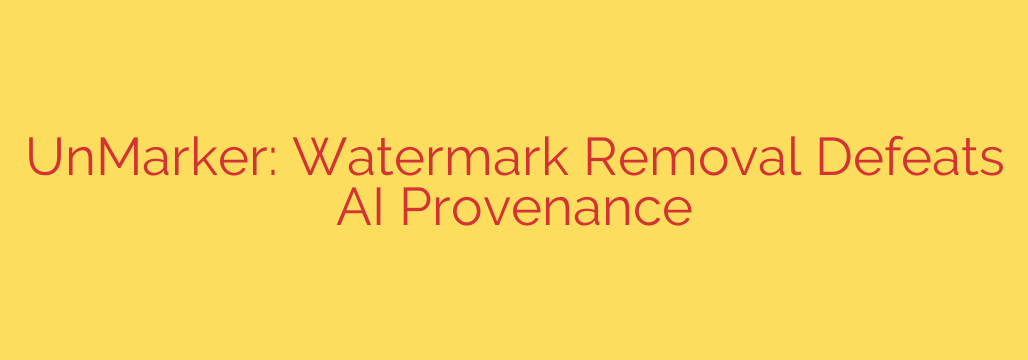
The Fragile State of AI Watermarks: How New Tools Are Erasing Digital Trust
In the rapidly expanding world of AI-generated content, the ability to distinguish between human-made and machine-made images is more critical than ever. For years, digital watermarking has been championed as a key solution for establishing provenance—a way to trace an image back to its source and verify its authenticity. This technology is our primary defense against the flood of deepfakes and misinformation.
However, the foundation of this trust is now being seriously challenged. New research has unveiled a powerful AI-powered method capable of erasing these digital fingerprints, threatening the entire framework of AI content moderation and authenticity.
The Promise of AI Provenance
Digital watermarks are designed to be a permanent signature embedded within an AI-generated image. They come in two main forms:
- Visible Watermarks: These are the logos or text overlays we commonly see, clearly marking an image’s origin (e.g., “Generated by DALL-E 3”).
- Invisible Watermarks: These are more sophisticated, embedding data directly into the pixels of an image in a way that is undetectable to the human eye but readable by specific algorithms.
The goal of both is to provide a clear, reliable signal that an image was created by a specific AI model. This helps technology platforms, news organizations, and the public identify synthetic media, curb the spread of deepfakes, and protect copyright. Unfortunately, this line of defense is proving to be more vulnerable than we thought.
A New AI Tool That Erases the Evidence
Researchers have developed a sophisticated AI tool that effectively “attacks” and removes watermarks from AI-generated images. This isn’t a simple photo editing trick; it’s a diffusion-based model, similar to the technology used to create AI images in the first place.
The tool works by identifying the watermarked area and then “re-drawing” or “in-painting” it with new, clean pixels that blend seamlessly with the rest of the image. The result is a watermark-free image that looks nearly identical to the original.
Crucially, this method has proven highly effective against both visible and invisible watermarks. In tests, it has demonstrated the ability to completely remove watermarks while preserving the image’s quality, making it nearly impossible to tell that a watermark was ever there. This breakthrough represents a significant escalation in the cat-and-mouse game between AI generation and detection.
Why This Is a Serious Security Threat
The ability to easily strip AI images of their identifying marks has profound and dangerous implications. Without reliable watermarking, we face several critical risks:
- Erosion of Public Trust: If any AI-generated image can be stripped of its watermark, the public will find it increasingly difficult to trust the authenticity of any digital content they see.
- The Rise of Undetectable Misinformation: Malicious actors can generate realistic fake images—of political events, public figures, or crises—and remove the AI watermark to pass them off as genuine. This makes it far easier to create and spread potent, believable disinformation at scale.
- Challenges for Content Moderation: Social media platforms and search engines rely on watermarks to enforce their policies against harmful or synthetic content. If these markers can be removed, their ability to automatically detect and flag deepfakes will be severely hampered.
- Intellectual Property and Copyright Theft: Artists and creators who use watermarks to protect their work could see them easily removed, enabling unauthorized use and distribution.
Actionable Security Tips in an Age of Uncertainty
While researchers work on developing more “robust” watermarking techniques that can resist such attacks, we must adapt to this new reality. The burden of verification can no longer rest on technology alone; it also requires human vigilance.
Here are a few essential tips for navigating the digital landscape:
- Cultivate a Healthy Skepticism: Treat all striking or emotionally charged images you encounter online with caution, especially if they lack a credible source. Ask yourself if the image looks too perfect or has any unusual artifacts.
- Verify the Source and Context: Before sharing an image, investigate its origin. Was it posted by a reputable news organization, an official account, or an anonymous user? Cross-reference the information with other trusted sources.
- Understand That No Detection Method is Foolproof: Relying on a single signal, like a watermark (or lack thereof), is no longer sufficient. A multi-layered approach to verification, combining technical tools with critical thinking, is essential.
The race to secure AI is accelerating. While this new watermark removal tool presents a formidable challenge, it also highlights the urgent need for a new generation of security protocols—from stronger cryptographic signatures to more advanced detection models. For now, the most powerful tool we have is our own critical judgment.
Source: https://go.theregister.com/feed/www.theregister.com/2025/07/24/ai_watermarks_unmarker/








